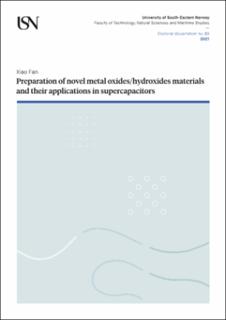Preparation of novel metal oxides/hydroxides materials and their applications in supercapacitors
Doctoral thesis
Published version
Permanent lenke
https://hdl.handle.net/11250/2735422Utgivelsesdato
2021Metadata
Vis full innførselSamlinger
Sammendrag
Supercapacitors, as next-generation efficient, safe and clean energy storage devices
with superior power density, fast charge/discharge rate, excellent temperature
adaptability and remarkable service life, significantly balance the conventional
capacitors and the batteries and have been adopted in many fields. Compared with
electric double-layer capacitors, pseudocapacitors can produce a higher specific
capacitance to satisfy the ever-growing demand, consequently becoming the research
hotspot. Co3O4, Ni(OH)2 and Co(OH)2, in view of overwhelming theoretical specific
capacitances, modest cost and environmental friendliness, have been extensively
recognized as the most promising electrode materials and trigged numerous efforts.
However, currently, the achieved specific capacitances of Co3O4 electrodes in previous
contributions are still lower than the theoretical value. Besides, the generally
accompanying poor rate performances further hinder the application. To address the
issue, the hollow Co3O4 spheres with high porosity and thin-wall feature were
synthesized. The as-fabricated Co3O4 electrode delivers a high specific capacitance of
988 F/g at 1 A/g and only 6.4% of its initial value decays at 20 A/g. Via analysis of the
formation mechanism of zeolitic imidazolate framework-67, the size adjustment in
preparation of hollow Co3O4 nanoboxes was obtained, which offers novel perspective
and approach for optimization of hollow Co3O4. The hollow Co3O4 nanoboxes electrode
exhibits large specific capacitances of 1832.7 and 1324.5 F/g at 1 and 20 A/g,
respectively.
Recently, the Ni-Co binary hydroxide, which outperforms the single hydroxide thanks to
the virtues of stronger layer orientation, increased active sites, reduced resistance and
so on, have sparked numerous attentions as a promising route to further enhance the
performances of Ni(OH)2 and Co(OH)2 based electrodes. Unfortunately, due to
undesirable morphology and involved binder, the progress to date is only in partial
fulfilment of the requirements of high performance supercapacitors. Aiming at the
defect, a morphology-controlled synthesis to grow Ni-Co binary hydroxide on nickel
foam directly (binder-free) was proposed, by which excellent overall supercapacitors
performances in terms of specific capacitance (2807 F/g at 1 A/g), rate capability (2222
F/g at 20 A/g) and cycling stability, together with comparable loading mass and facile
fabricated method were obtained. In addition, the supercapacitors behaviors of flowerlike
ZnWO4, a potential alternative electrode material, were investigated.

